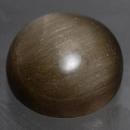|
Click on a letter above to view the list of gems. |
|
|
|
|
|
|
|
|
Crocidolite
(variety
of Riebeckite)
|
|
| | |
| Discovered in 1815; IMA status: Riebeckite is Valid (pre-IMA; Grandfathered) | ||
|
| ||
|
Information below is for Riebeckite | |
|
|
|
|
Chemistry |
|
|
| |
|
Na2Fe2+3Fe3+2(Si8O22)(OH)2 | |
|
|
Iron Sodium Silicate Hydroxide |
|
Molecular Weight: |
935.90 gm |
|
Composition: |
Sodium |
4.91 % |
Na |
6.62 % |
Na2O |
|
|
Iron |
29.84 % |
Fe |
23.03 % |
FeO / 17.06% Fe2O3 |
|
|
Silicon |
24.01 % |
Si |
51.36 % |
SiO2 |
|
|
Hydrogen |
0.22 % |
H |
1.92 % |
H2O |
|
|
Oxygen |
41.03 % |
O |
|
|
|
|
|
100.00 % |
|
100.00 % |
= TOTAL OXIDE |
|
|
|
||||
|
Classification |
|
|
| |
|
Silicates (Germanates) | |
|
8/F.08-50 | |
|
|
9 : SILICATES (Germanates) |
|
Related to: |
Amphibole Group. Sodic Clino-Amphibole Subgroup. Magnesioriebeckite-Riebeckite Series. |
|
Varieties: |
Crocidolite is a variety of Riebeckite |
|
Synonyms: |
Abriachanite, Blue Asbestos, Blue Ironstone, Cape Asbestos, Cape Blue, Krokydolith, South African cat's eye |
|
|
|
|
Crystal Data |
|
|
|
|
|
As prismatic crystals, to 20 cm. Commonly fibrous, asbestiform; earthy, massive. |
|
|
Simple or multiple twinning || {100}. |
|
|
|
|
|
Physical Properties |
|
|
|
|
|
Perfect on {110} intersecting at 56° and 124°; partings on {100}, {010} |
|
|
Conchoidal to Uneven, Splintery |
|
|
Brittle |
|
|
5.0 - 6.0 |
|
|
3.28 - 3.44 (g/cm3) |
|
|
None |
|
|
Not Radioactive |
|
|
Other: |
An asbestos mineral. Fibres, if breathed in, can cause serious and irreversable lung damage. Avoid exposure to dust. |
|
|
|
|
Optical Properties |
|
|
|
|
|
Gray-Blue to leek-Green |
|
|
Semi-transparent to Opaque |
|
|
Vitreous to Silky |
|
|
1.656 - 1.740 Biaxial ( + ) or ( - ) |
|
|
0.005 - 0.008 |
|
|
Strong |
|
|
X = blue, indigo; Y = yellowish green, yellowbrown; Z = dark blue |
|
|
Other: |
Exhibits chatoyance and cat's eye effect |
|
|
|
|
Occurances |
|
|
|
|
|
Geological Setting: |
In alkalic granites and syenites; rarer in felsic volcanics and granite pegmatites; in some schists. In iron formations as asbestiform "Crocidolite." |
|
Common Associations: |
Aegirine, Nepheline, Albite, Arfvedsonite (igneous); Tremolite, Ferro-actinolite (metamorphic); Grunerite, Magnetite, Hematite, Stilpnomelane, Ankerite, Siderite, Calcite, Chalcedony, Quartz (iron formations) |
|
Common Impurities: |
Fe, Ti, Mg, Al, Mn |
|
Type Locality: |
Socotra Island, Adan Governorate, Yemen |
|
Year Discovered: |
1815 (Crocidolite); 1888 (Riebeckite) |
|
View mineral photos: | |
|
|
|
|
More Information |
|
|
|
|
|
|
Mindat.org
(Crocidolite) |
|
|
|
|
|
|
|
We
have not photographed our Crocidolite gems. Please
check back soon. |
